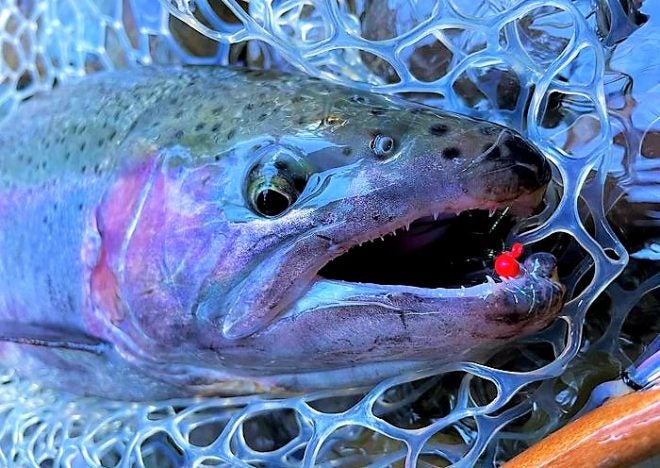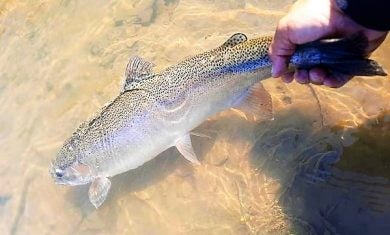The fishing is hot in Steelhead Alley – what to know before you go
Megan Plete Postol 03.17.23

In a fishing zone known nationally as “Steelhead Alley,” feisty steelhead are currently packing the waters in near record numbers, to the delight of visiting anglers.
This year’s winter weather has been variable, with extended periods of no snow to heavy snow, amidst very cold to very warm periods, with anglers trying to choose between ice fishing or heading to the streams to enjoy fishing in any of the many Chautauqua County Lake Erie tributaries. Anglers have been busy welcoming the steelhead. With each warming period following the New Year’s Day holiday, the tackle-busting steelies have been migrating in schools from Lake Erie to enter their favorite Chautauqua County tributary stream, preparing to spawn. The angler action has been legendary these last few weeks and will continue through April.
Where to go
One of the most popular tributary fishing hotspots located just south of Dunkirk, NY, is Canadaway Creek, where it meets Lake Erie. This steelhead and brown trout entry point offers angler parking and easy walkway paths to the stream. The fish enter via Canadaway Creek and swim upstream to Laona Falls, about six miles. As waters warm, this area is a hotspot for first-of-the-year smallmouth bass action. Just north of Dunkirk, Silver Creek joins Lake Erie to offer several miles of small water trib fishing from the mouth to King’s Road. Walnut Creek is another small but famous tributary that flows into Silver Creek and offers productive fishing upstream to Forestville, NY. Both streams usually run less stained when the larger tributary streams run muddy after heavy rainfall or snowmelt. Farther north, Cattaraugus Creek at Hanover is the largest of all Chautauqua County Lake Erie tributaries. The first 6 miles of this magnificent steelhead waterway in Chautauqua County provides angler access for shore fishing or boat fishing (Note: From Nov. 1 to May 1, anglers fishing from a boat must wear a personal floatation device – this includes canoes, kayaks, rowboats and motorboats).
Chautauqua Creek in Westfield, NY, heading south, is a five-star steelhead stream with ample angler parking and easy angler access at several points along the stream. A few miles from the mouth, this beautiful water flow meanders through a picturesque and deeply carved gorge known as Chautauqua Gorge, offering more than eight miles of peaceful, public fishing rights for anglers. Focus on the water flowage above and below the Railroad Bridge and Interstate 90 Bridge as hotspot fishing zones.
Fishing Gear
Fishing gear can be simple or complicated, and it can be inexpensive or costly. For this type of fishing it really comes down to the angler’s preference. Short and long fishing rods catch fish, with angler preference factors directly related to the gear presentation capability and strike detection sensitivity provided to the angler. Strike indicators (more universally called bobbers) are commonly used for steelhead fishing to identify the lightest steelhead bite. The bobbers are available in many facets of style, from the standard round bobber to sophisticated quill bobbers, and are used by anglers fishing with many fishing gear options.

Spinning Rods are more popular than fly rods, though center-pin/fly rod style rods and reels have taken the front seat of new gear among dedicated steelhead anglers. The center-pin reels utilize long flexible fishing rods with extremely lightweight leaders to allow extremely long drift presentations to wary fish – even with the gin-clear water clarity. The combo will also provide low resistance to fool the spookiest clear water steelhead. Like fly reels, the center-pin reels have a considerably large diameter arbor that hold hundreds of yards of braided and backer lines. The fighting end of the braided line will attach to monofilament or fluorocarbon using a double-uni knot or a double surgeon’s knot, then to a lighter fluorocarbon leader, and finally to a fly, nymph, streamer, lightweight jig (1/32 or 1/64 ounce), or the most simple – a circle hook touting a natural or artificial egg sac presentation, or to the more recently most popular: a plastic bead. The strike indicator is usually placed about two to four feet above the hook to allow the presentation to drift off the bottom at about a foot or so. Anglers use a tiny rubber bobber stop placed above and below the bobber to allow bobber height changes without slippage. Salmon egg fly patterns, streamer flies, wooly buggers, egg-sucking leeches, olive-colored Zonker flies, stonefly nymphs, and a local favorite: the old-fashioned hare’s ear wet fly. All these are popular fly angler choices. These flies also work well with spinning rod anglers using strike indicators.
Regulations
While there is no closed season for trout and salmon in Lake Erie tributaries, there are special seasonal regulations that do apply to all Lake Erie tributaries from Sep. 1 to Mar. 31. These special rules apply from the bridge closest to the mouth upstream to the first barrier impassable by fish. Fishing is allowed from 1/2 hour before sunrise to 1/2 hour after sunset (fishing at night is prohibited), and for hook size, the distance between a hook shaft and point cannot exceed 1/2 inch. Hooks attached to any artificial lure must be free-swinging, except on an artificial fly or jig. In addition, in Chautauqua Creek, from the bridge on South Gale Street upstream 1.3 miles to the upper Village of Westfield water intake dam, this is a catch and release zone for trout and salmon.
Generally, for all Lake Erie tributaries of Chautauqua County, a 12-inch minimum size limit and a daily bag limit of three fish per person are allowed. Anglers are encouraged to check NYS DEC fishing regulations. Keep in mind that catch and release are encouraged. Steelhead can live for 20 years or more.